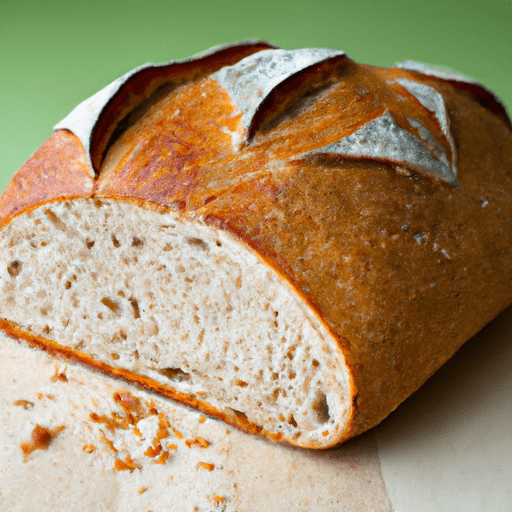The Delicious World of Low-Carb Bread: A Guilt-Free Slice of Heaven
Bread, a staple food for many, has long been cherished for its comforting taste and versatility. But for those watching their carb intake, traditional bread can be a dietary challenge. That’s where low-carb bread comes to the rescue! In this blog post, we’ll dive into the wonderful world of low-carb bread, exploring its taste, common uses in cooking, nutritional value, and a few interesting historical and fun facts. So, tighten your apron strings and let’s get started!
Taste: Flavorful with a Twist
Low-carb bread offers a surprisingly satisfying taste that mimics its high-carb counterparts. Made with low-carb ingredients like almond or coconut flour, flaxseed meal, and psyllium husk, this bread is often dense and moist, with a slightly nutty and savory flavor. Despite its lower carb content, it can still be toasted to perfection and enjoyed with your favorite toppings, from avocado and poached eggs to almond butter and sugar-free jam.
Cooking and Everyday Uses
From sandwiches to French toast, low-carb bread is a versatile ingredient that opens up a world of culinary possibilities. It can be used just like regular bread, allowing you to enjoy your favorite lunchtime classics while keeping your carb intake in check.
Sandwich Supreme
Building a low-carb sandwich involves creativity and an array of delicious ingredients. Opt for a protein-rich filling such as grilled chicken, sliced turkey, or smoked salmon. Add some crunch with fresh lettuce, cucumber, or sprouts. Finally, enhance the flavor with a smear of low-carb mayo, Dijon mustard, or a homemade avocado spread. The result? A satisfying, guilt-free sandwich that won’t compromise your dietary goals.
French Toast Reimagined
Who said French toast has to be carb-heavy? With low-carb bread, you can still savor this breakfast favorite while maintaining a low-carb lifestyle. Prepare your French toast mixture with a blend of eggs, unsweetened almond milk, and a sprinkle of cinnamon. Dip your low-carb bread slices into the mixture, then cook them on a lightly greased non-stick skillet until golden brown. Serve with a drizzle of sugar-free syrup or a dusting of powdered erythritol for a truly delightful morning treat.
Nutritional Value: The Healthy Side of Low-Carb Bread
Low-carb bread not only pleases the taste buds but also offers some enticing nutritional benefits. While the exact composition can vary between brands and recipes, most low-carb breads are high in protein, fiber, and healthy fats. These qualities can help keep you feeling fuller for longer, promote stable blood sugar levels, and support your dietary goals.
Historical and Fun Facts
Curious about the origins of low-carb bread? Let’s journey back in time for a moment. The concept of low-carb bread traces its roots to Dr. Robert Atkins, a renowned physician who popularized the Atkins diet in the early 1970s. As part of his dietary approach, Dr. Atkins introduced a bread recipe that replaced refined wheat flour with high-protein ingredients, reducing the overall carbohydrate content. Since then, low-carb bread has continued to evolve, inspiring countless home cooks and bakers to explore and innovate in the realm of low-carb cooking.
Conclusion
Low-carb bread represents an enticing alternative for those seeking a bread with fewer carbs, without compromising on taste and versatility. With its flavorful profile and endless culinary applications, it opens up a world of creative and healthier possibilities. So, whether you are following a low-carb diet or simply looking for a delightful twist on your favorite sandwich or French toast recipe, give low-carb bread a try. Your taste buds and waistline will thank you!
Now, it’s time to roll up your sleeves, head to your kitchen, and embark on a low-carb bread adventure. Enjoy exploring the diverse recipes and benefits that this delicious, guilt-free loaf has to offer!
Origin:
Low-carb bread is a modern variation of traditional bread and is specifically designed to have fewer carbohydrates. It originated as a response to the increasing popularity of low-carb diets, such as the Atkins and ketogenic diets, which promote limiting carbohydrate intake to support weight loss and better blood sugar control.
Common Uses:
Low-carb bread is commonly used as a substitute for traditional bread in various dishes and sandwiches. It can be used to make toast, sandwiches, burgers, and other baked goods like low-carb rolls and wraps.
Nutritional Benefits:
Low-carb bread offers several potential nutritional benefits, such as:
Lower Carbohydrate Content: Compared to conventional bread, low-carb bread typically contains significantly fewer carbohydrates. This can be beneficial for those following a low-carb diet or individuals looking to reduce their overall carbohydrate intake.
Higher Protein Content: Many low-carb bread recipes incorporate high-protein ingredients like almond flour or whey protein. This can help increase the protein content of the bread, which may promote feelings of fullness and support muscle building and maintenance.
Increased Fiber: Some low-carb breads are enriched with fiber-rich ingredients like psyllium husk or flaxseed. This can improve digestion, promote bowel regularity, and potentially help manage blood sugar levels.
Lower Glycemic Index: Low-carb breads may have a lower glycemic index compared to regular bread. This means they cause a slower and more gradual rise in blood sugar levels after consumption, which can be particularly beneficial for people with diabetes.
Unique Properties and Historical Significance:
The creation of low-carb bread reflects our evolving understanding of nutrition and dietary preferences. While traditional bread has been a staple food for centuries, the demand for low-carb options has grown in recent years due to increasing awareness of the potential health benefits associated with reducing carbohydrate intake.
Low-carb bread is a testament to the versatility of food and the ability to adapt traditional recipes to fit modern dietary needs. It provides an alternative for people who desire the texture and taste of bread while managing their carbohydrate intake. Although low-carb bread may not be an ancient or historically significant food, it demonstrates the way food continues to evolve to accommodate changing dietary practices.




Use the share button below if you liked it.
It makes me smile, when I see it.